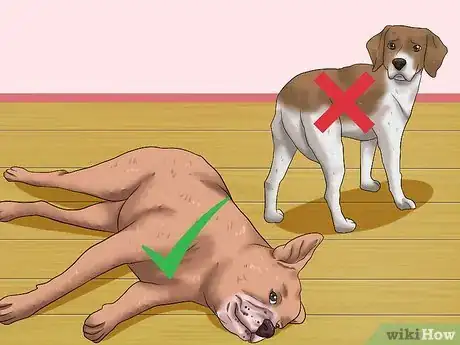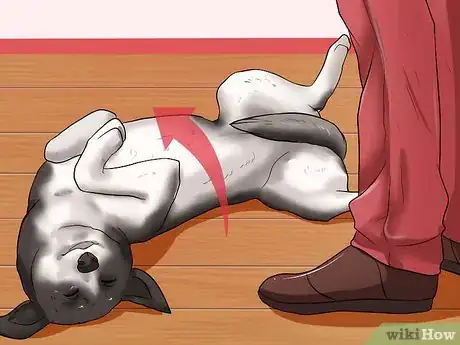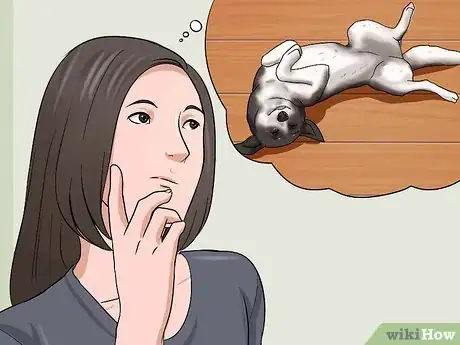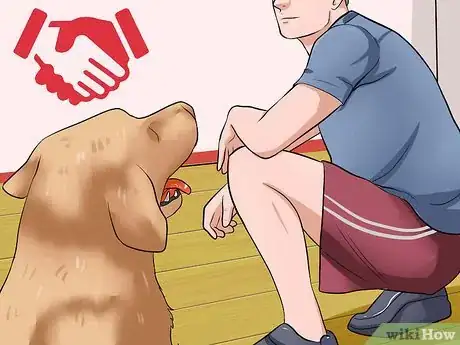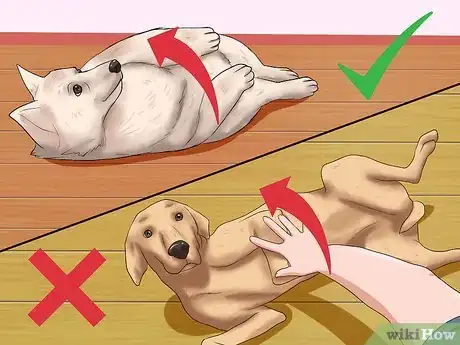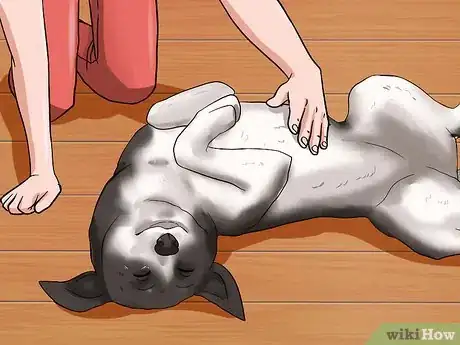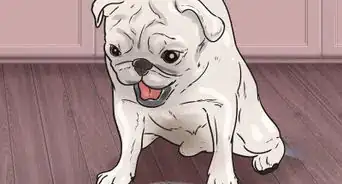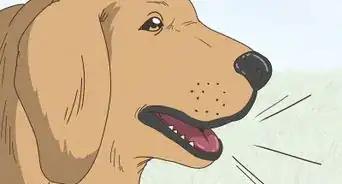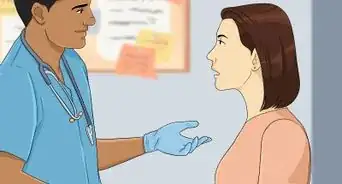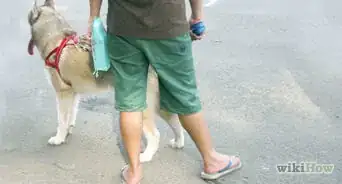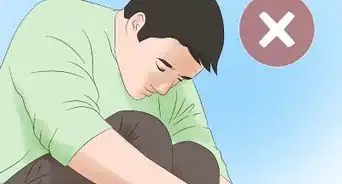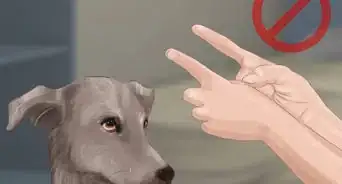This article was co-authored by Pippa Elliott, MRCVS. Dr. Elliott, BVMS, MRCVS is a veterinarian with over 30 years of experience in veterinary surgery and companion animal practice. She graduated from the University of Glasgow in 1987 with a degree in veterinary medicine and surgery. She has worked at the same animal clinic in her hometown for over 20 years.
wikiHow marks an article as reader-approved once it receives enough positive feedback. In this case, 86% of readers who voted found the article helpful, earning it our reader-approved status.
This article has been viewed 113,138 times.
Rubbing a dog’s tummy seems like a pretty easy thing to do. Dogs love to have their tummies rubbed, so it may not seem obvious as to why such a pleasurable and easy activity needs further instruction and explanation. Rather than assume that your dog is in the mood for a tummy rub, take some time to understand his body language and learn how to rub his belly the right way.
Steps
Understanding Your Dog’s Body Language
-
1Observe your dog’s posture. Before you start rubbing your dog’s belly, look at his posture. If his body looks fluid and loose, then he’s feeling pretty relaxed and happy.[1] If he looks tense, then he may not be very receptive to having his belly rubbed.
- If your dog is sleeping, let him sleep rather than waking him up to rub his tummy.
-
2Determine if your dog is being submissive. Approach your dog. If your dog rolls onto his back as soon as you get closer to him, he is likely demonstrating submissive behavior. This submissive behavior may be accompanied by other submissive actions, such as licking the lips and tucking the tail. To the untrained eye, these actions look like an open invitation by your dog to rub his belly, but this is not necessarily the case.[2]
- If your dog becomes submissive when you approach him, he may actually be intimidated by you and will not want you to rub his tummy right away.
- To make him more feel comfortable with you, get on the ground a small distance away from him. Call out to him and let him come over to you. When you call him, do not reach out to get him to come closer.[3]
Advertisement -
3Understand why your dog presents his belly. Your dog may present his belly as a form of submission, but he may also be showing that he trusts you or wants to play.[4] [5] It is not always obvious what type of behavior your dog is showing. If you are unsure if your dog is being submissive versus being trusting or playful, your veterinarian can help you more fully understand the differences.
- When a dog lies on his back, he is putting himself in a vulnerable position. Provided that you and your dog have developed a close bond, he will probably be comfortable with allowing you to rub his tummy.[6]
Rubbing a Dog’s Tummy
-
1Gain your dog’s trust. If you and your dog have already established a trusting relationship, then you are well on your way to rubbing your dog’s tummy with ease. However, if your dog doesn’t fully trust you yet, there are a few things that you can do to gain his trust.[7]
- Be calm when you approach him. If your dog hasn’t quite warmed up to you, staying calm as you approach him will help him see that you are not threatening and that he can trust you.
- Approach him from the side, rather walking towards him from the front; approaching him from the front could be intimidating for him. When you reach his side, kneel down or sit in the same direction that he is facing. Do not make eye contact, since direct eye contact can be perceived as a threat.[8]
- When he is more comfortable with you being close to him, you can sit by his side and gently pet him. Talking to him in quiet and soothing tones will reduce anxiety that he may have with you touching him.
-
2Observe if your dog rolls over. If your dog does not roll over on his own, he probably does not want to have his tummy rubbed. It is very important that you never force your dog to lie on his side; this can make him anxious and upset with you.[9] Be respectful of his wish not to have his tummy rubbed.
-
3Pet your dog’s chest. Before rubbing your dog’s his tummy, start by petting his chest. If he growls or snarls when you start petting him, stop petting him right away. He’s giving you a very strong indication that he does not want to be petted.
- The growls and snarls can also be signs of aggression. A number of things, such as pain or behavioral disorders, could cause the aggression. Your veterinarian can conduct various medical and behavior tests to determine the cause of the aggression.[10]
- If your dog is not showing signs of displeasure when you start petting him, continue to pet his chest. You can even weave your fingers through his fur to get him to be more comfortable.
-
4Rub your dog's tummy. When your dog has become comfortable with you petting his chest, move your hand down his body to start rubbing his tummy. By now, he should be very relaxed. Use slow and sweeping movements. Talking to him in quiet and soothing tones will help to keep him relaxed.
- Your dog may start kicking his back leg when you rub his tummy. Contrary to what many people think, this is not a sign that you hit your dog’s ticklish spot. His leg-kicking is actually an involuntary response called the scratch reflex.[11]
- The scratch reflex occurs when nerves that are connected to your dog’s spinal cord are activated under the skin. Your dog will kick his leg automatically because his body perceives the nerve activation as an irritant on the skin. If you see your dog’s leg start to kick automatically, stop rubbing him in that area of his tummy and move to another area.[12]
- If your dog seems to be enjoying the tummy rub, but then gets up and walks away, he is letting you know that he no longer wants his tummy to be rubbed. This is completely normal behavior, so there is no need to be concerned.[13]
- If you feel his body tensing up when you rub his tummy, but then relaxes after you stop, he is giving you another indication that now is not the right time for a tummy rub.[14]
Expert Q&A
-
QuestionWe have a new dog who seems to trust us. When I pet him, he rolls on his side and lifts a front leg. Does this mean he wants to be petted?
 Pippa Elliott, MRCVSDr. Elliott, BVMS, MRCVS is a veterinarian with over 30 years of experience in veterinary surgery and companion animal practice. She graduated from the University of Glasgow in 1987 with a degree in veterinary medicine and surgery. She has worked at the same animal clinic in her hometown for over 20 years.
Pippa Elliott, MRCVSDr. Elliott, BVMS, MRCVS is a veterinarian with over 30 years of experience in veterinary surgery and companion animal practice. She graduated from the University of Glasgow in 1987 with a degree in veterinary medicine and surgery. She has worked at the same animal clinic in her hometown for over 20 years.
Veterinarian Rolling over and showing the tummy is a sign of submission, as indeed is raising a front paw. It could be the dog is showing you that he accepts you as boss and isn't going to challenge your authority. Alternatively, he may just be enjoying the attention.
Rolling over and showing the tummy is a sign of submission, as indeed is raising a front paw. It could be the dog is showing you that he accepts you as boss and isn't going to challenge your authority. Alternatively, he may just be enjoying the attention. -
QuestionDoes a belly rub tickle?
 Pippa Elliott, MRCVSDr. Elliott, BVMS, MRCVS is a veterinarian with over 30 years of experience in veterinary surgery and companion animal practice. She graduated from the University of Glasgow in 1987 with a degree in veterinary medicine and surgery. She has worked at the same animal clinic in her hometown for over 20 years.
Pippa Elliott, MRCVSDr. Elliott, BVMS, MRCVS is a veterinarian with over 30 years of experience in veterinary surgery and companion animal practice. She graduated from the University of Glasgow in 1987 with a degree in veterinary medicine and surgery. She has worked at the same animal clinic in her hometown for over 20 years.
Veterinarian Dogs are all individuals; with some, rubbing a certain spot on their belly will make them scratch with a back leg in an uncontrolled way, which is a sign you hit the ticklish spot.
Dogs are all individuals; with some, rubbing a certain spot on their belly will make them scratch with a back leg in an uncontrolled way, which is a sign you hit the ticklish spot.
References
- ↑ https://positively.com/dog-training/understanding-dogs/canine-body-language/
- ↑ http://www.vetstreet.com/our-pet-experts/why-does-my-dog-like-to-have-his-belly-rubbed
- ↑ http://www.vetstreet.com/our-pet-experts/why-does-my-dog-like-to-have-his-belly-rubbed
- ↑ http://www.vetstreet.com/our-pet-experts/why-does-my-dog-like-to-have-his-belly-rubbed
- ↑ http://www.puppyleaks.com/dogs-like-belly-rubs/
- ↑ http://www.puppyleaks.com/dogs-like-belly-rubs/
- ↑ http://www.cesarsway.com/dog-behavior/basics/How-to-get-a-dog-to-trust-you
- ↑ http://www.cesarsway.com/dog-behavior/basics/How-to-get-a-dog-to-trust-you
- ↑ http://www.vetstreet.com/our-pet-experts/why-does-my-dog-like-to-have-his-belly-rubbed
About This Article
Your dog probably loves to have its tummy rubbed, but you should only rub it when your dog rolls over on its own. Never force your dog to lay on its side for a belly rub because this can make it anxious and upset with you. If you think your dog wants its belly rubbed, you can actually start by petting its chest, and if it growls or snarls, stop petting right away. If not, keep rubbing down to its belly in slow, sweeping movements, and talk to it quietly to help keep it relaxed. Even though it might look cute, avoid rubbing a spot if your dog starts to kick its leg because that’s actually a reflex it has when its skin gets irritated. For more tips from our Veterinary co-author, like how to better read your dog’s body language, scroll down!
